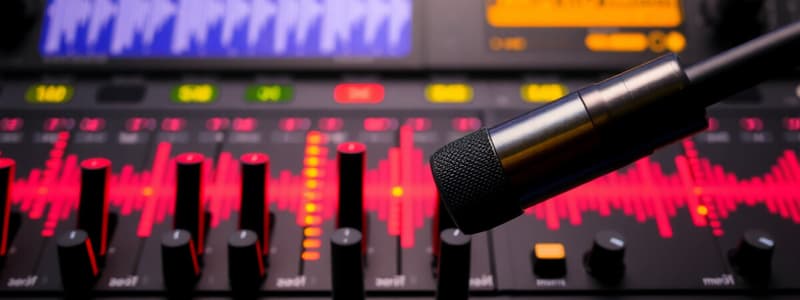Podcast
Questions and Answers
What does the term 'waveform' refer to in audio production?
What does the term 'waveform' refer to in audio production?
- The frequency of a sound
- The digital representation of sound
- The shape of a sound (correct)
- The energy level of sound
A silent waveform appears as a straight horizontal line on a waveform graph.
A silent waveform appears as a straight horizontal line on a waveform graph.
True (A)
Name the three critical parts of audio that are important to understand in audio production.
Name the three critical parts of audio that are important to understand in audio production.
waveform, frequency, amplitude
Pro Tools is recognized as a preeminent Digital Audio __________ (DAW).
Pro Tools is recognized as a preeminent Digital Audio __________ (DAW).
What aspect of sound refers to its energy level?
What aspect of sound refers to its energy level?
Match the following waveforms to their descriptions:
Match the following waveforms to their descriptions:
Digital audio technology has remained static over the years.
Digital audio technology has remained static over the years.
What is the primary reason many professionals choose Pro Tools as their DAW?
What is the primary reason many professionals choose Pro Tools as their DAW?
Pro Tools allows for non-destructive effects processing.
Pro Tools allows for non-destructive effects processing.
Name one major advantage of using Pro Tools for MIDI functions.
Name one major advantage of using Pro Tools for MIDI functions.
Pro Tools can record up to __________ audio signals at a time in its Studio version.
Pro Tools can record up to __________ audio signals at a time in its Studio version.
Match the Pro Tools version to the maximum number of channels for input and output:
Match the Pro Tools version to the maximum number of channels for input and output:
Which Pro Tools version is required for surround sound mixing?
Which Pro Tools version is required for surround sound mixing?
All versions of Pro Tools share the same fundamental architecture.
All versions of Pro Tools share the same fundamental architecture.
What component of Pro Tools is known for capturing and playing back audio with high fidelity?
What component of Pro Tools is known for capturing and playing back audio with high fidelity?
The term __________ refers to a series of steps or features used to get a job done in audio production.
The term __________ refers to a series of steps or features used to get a job done in audio production.
What view in Pro Tools helps users who can read music notation to visualize MIDI data?
What view in Pro Tools helps users who can read music notation to visualize MIDI data?
What is the phase of an audio waveform where energy is increasing and then decreasing?
What is the phase of an audio waveform where energy is increasing and then decreasing?
Low-frequency sounds have a higher Hertz value than high-frequency sounds.
Low-frequency sounds have a higher Hertz value than high-frequency sounds.
What unit is frequency measured in?
What unit is frequency measured in?
A sound's energy level is referred to as its ______.
A sound's energy level is referred to as its ______.
Match the following terms with their definitions:
Match the following terms with their definitions:
Which sound waveform is typically described as very simple and pure?
Which sound waveform is typically described as very simple and pure?
Humans can hear sounds with frequencies from 20 Hz to 20 kHz regardless of age.
Humans can hear sounds with frequencies from 20 Hz to 20 kHz regardless of age.
What is the maximum human dynamic range in decibels?
What is the maximum human dynamic range in decibels?
The ______ phase occurs when the air pressure drops below the zero line in an audio waveform.
The ______ phase occurs when the air pressure drops below the zero line in an audio waveform.
What describes the relationship between amplitude and perceived loudness?
What describes the relationship between amplitude and perceived loudness?
All audio waveforms are solely comprised of compression and rarefaction phases.
All audio waveforms are solely comprised of compression and rarefaction phases.
What is the term used for one complete cycle of compression and rarefaction?
What is the term used for one complete cycle of compression and rarefaction?
Sound waves that have greater amplitude can be heard over greater ______.
Sound waves that have greater amplitude can be heard over greater ______.
Match the following frequency ranges with their corresponding animals:
Match the following frequency ranges with their corresponding animals:
What is the Nyquist frequency when the sample rate is 44.1 kHz?
What is the Nyquist frequency when the sample rate is 44.1 kHz?
Aliasing occurs when there are two or more samples per cycle when recording audio.
Aliasing occurs when there are two or more samples per cycle when recording audio.
What does A/D conversion stand for?
What does A/D conversion stand for?
A sample measures the amplitude of an audio signal at a specific moment in time, making it a measurement of _______.
A sample measures the amplitude of an audio signal at a specific moment in time, making it a measurement of _______.
Match the following sample rates with their corresponding samples per second:
Match the following sample rates with their corresponding samples per second:
Which bit depth provides a greater number of discrete amplitude levels?
Which bit depth provides a greater number of discrete amplitude levels?
The sample rate must be less than the highest frequency of the sound to accurately record it.
The sample rate must be less than the highest frequency of the sound to accurately record it.
What is foldback in audio recording?
What is foldback in audio recording?
A sine wave with sufficient sample rate can be accurately ________ and played back.
A sine wave with sufficient sample rate can be accurately ________ and played back.
Match the following sample rates with their common usage:
Match the following sample rates with their common usage:
Which of the following is measured in Hertz?
Which of the following is measured in Hertz?
A sample can represent multiple measurements of an audio signal at once.
A sample can represent multiple measurements of an audio signal at once.
Who co-created the Nyquist-Shannon sampling theorem?
Who co-created the Nyquist-Shannon sampling theorem?
Higher bit depths allow you to record with greater _____ range.
Higher bit depths allow you to record with greater _____ range.
What is the maximum dynamic range of 16-bit audio?
What is the maximum dynamic range of 16-bit audio?
How much larger is a 24-bit audio file compared to a 16-bit file of the same sample rate and duration?
How much larger is a 24-bit audio file compared to a 16-bit file of the same sample rate and duration?
The maximum dynamic range of a human being is approximately 144 dB.
The maximum dynamic range of a human being is approximately 144 dB.
Digital Audio Workstations combine audio and MIDI recording capabilities.
Digital Audio Workstations combine audio and MIDI recording capabilities.
What is the primary purpose of a session file in Pro Tools?
What is the primary purpose of a session file in Pro Tools?
One minute of 24-bit/44.1 kHz mono audio requires about _____ MB of storage space.
One minute of 24-bit/44.1 kHz mono audio requires about _____ MB of storage space.
Match the following bit depths with their corresponding maximum dynamic range:
Match the following bit depths with their corresponding maximum dynamic range:
Which of the following sample rates corresponds to a file size of approximately 10.09 MB for a 32-bit audio file?
Which of the following sample rates corresponds to a file size of approximately 10.09 MB for a 32-bit audio file?
What does a clip represent in Pro Tools?
What does a clip represent in Pro Tools?
Non-linear editing means that clips can only be moved in fixed positions on the timeline.
Non-linear editing means that clips can only be moved in fixed positions on the timeline.
The method of editing that allows changes without losing original data is called _____ editing.
The method of editing that allows changes without losing original data is called _____ editing.
What will happen to the file size if the sample rate is doubled?
What will happen to the file size if the sample rate is doubled?
Which company developed the Digital Audio Workstation called Pro Tools?
Which company developed the Digital Audio Workstation called Pro Tools?
What is the dynamic range of a 32-bit floating point audio file?
What is the dynamic range of a 32-bit floating point audio file?
Match the following audio file specifications with their required storage size:
Match the following audio file specifications with their required storage size:
The website run by mastering engineer Bob Katz is called _____ .
The website run by mastering engineer Bob Katz is called _____ .
Which of the following concepts is crucial for comprehending audio production?
Which of the following concepts is crucial for comprehending audio production?
What role does bit depth play in audio production?
What role does bit depth play in audio production?
Which measurement is essential for understanding an audio signal's amplitude?
Which measurement is essential for understanding an audio signal's amplitude?
Which factor affects how accurately an audio signal is captured and reproduced?
Which factor affects how accurately an audio signal is captured and reproduced?
Flashcards
Waveform
Waveform
The shape of a sound, representing its characteristics, like how it vibrates in the air.
Frequency
Frequency
The rate at which sound waves vibrate, determining the pitch of a sound.
Amplitude
Amplitude
The intensity or volume of a sound, determined by the amplitude of the sound waves.
Digital Audio Conversion
Digital Audio Conversion
Signup and view all the flashcards
Digital Audio Workstation (DAW)
Digital Audio Workstation (DAW)
Signup and view all the flashcards
Compression and Rarefaction
Compression and Rarefaction
Signup and view all the flashcards
Sine wave
Sine wave
Signup and view all the flashcards
Square wave
Square wave
Signup and view all the flashcards
Compression Phase
Compression Phase
Signup and view all the flashcards
Rarefaction Phase
Rarefaction Phase
Signup and view all the flashcards
Cycle
Cycle
Signup and view all the flashcards
Hertz (Hz)
Hertz (Hz)
Signup and view all the flashcards
Decibel (dB)
Decibel (dB)
Signup and view all the flashcards
Human Hearing Range
Human Hearing Range
Signup and view all the flashcards
Human Dynamic Range
Human Dynamic Range
Signup and view all the flashcards
High-Frequency Hearing Loss
High-Frequency Hearing Loss
Signup and view all the flashcards
Loudness
Loudness
Signup and view all the flashcards
dB FS (Full Scale)
dB FS (Full Scale)
Signup and view all the flashcards
Sample (in Digital Audio)
Sample (in Digital Audio)
Signup and view all the flashcards
Sample Rate
Sample Rate
Signup and view all the flashcards
Nyquist Frequency
Nyquist Frequency
Signup and view all the flashcards
Foldback or Aliasing
Foldback or Aliasing
Signup and view all the flashcards
Bit Depth
Bit Depth
Signup and view all the flashcards
Dynamic Range
Dynamic Range
Signup and view all the flashcards
Analog-to-Digital (A/D) Conversion
Analog-to-Digital (A/D) Conversion
Signup and view all the flashcards
Digital-to-Analog (D/A) Conversion
Digital-to-Analog (D/A) Conversion
Signup and view all the flashcards
Nyquist-Shannon Sampling Theorem
Nyquist-Shannon Sampling Theorem
Signup and view all the flashcards
Sine wave with adequate samples
Sine wave with adequate samples
Signup and view all the flashcards
Sine wave with insufficient samples
Sine wave with insufficient samples
Signup and view all the flashcards
Analog-to-Electrical Conversion
Analog-to-Electrical Conversion
Signup and view all the flashcards
Electrical-to-Analog Conversion
Electrical-to-Analog Conversion
Signup and view all the flashcards
Loudness Perception of Different Frequencies
Loudness Perception of Different Frequencies
Signup and view all the flashcards
DAW
DAW
Signup and view all the flashcards
Real-time Processing
Real-time Processing
Signup and view all the flashcards
Pro Tools
Pro Tools
Signup and view all the flashcards
Workflow
Workflow
Signup and view all the flashcards
Tracks
Tracks
Signup and view all the flashcards
Pro Tools Versions
Pro Tools Versions
Signup and view all the flashcards
Inputs and Outputs
Inputs and Outputs
Signup and view all the flashcards
Stereo vs. Surround Sound
Stereo vs. Surround Sound
Signup and view all the flashcards
MIDI
MIDI
Signup and view all the flashcards
Piano Roll View
Piano Roll View
Signup and view all the flashcards
Dynamic Range of Audio Formats
Dynamic Range of Audio Formats
Signup and view all the flashcards
Impact of Sample Rate and Bit Depth on File Size
Impact of Sample Rate and Bit Depth on File Size
Signup and view all the flashcards
Session File
Session File
Signup and view all the flashcards
Project File
Project File
Signup and view all the flashcards
Clip
Clip
Signup and view all the flashcards
Non-Linear Audio Editing
Non-Linear Audio Editing
Signup and view all the flashcards
Non-Destructive Audio Editing
Non-Destructive Audio Editing
Signup and view all the flashcards
Fixed-Point Bit Depth
Fixed-Point Bit Depth
Signup and view all the flashcards
Floating-Point Bit Depth
Floating-Point Bit Depth
Signup and view all the flashcards
Tapeless Studio System
Tapeless Studio System
Signup and view all the flashcards
What are the three critical parts of audio?
What are the three critical parts of audio?
Signup and view all the flashcards
What is frequency?
What is frequency?
Signup and view all the flashcards
What is amplitude?
What is amplitude?
Signup and view all the flashcards
What is loudness?
What is loudness?
Signup and view all the flashcards
Why are frequency, amplitude, and loudness important in audio production?
Why are frequency, amplitude, and loudness important in audio production?
Signup and view all the flashcards
Study Notes
Audio Basics
- Sound consists of waveform, frequency, and amplitude.
- Waveform: The shape of a sound. Silent audio appears as a straight horizontal line.
- Compression and rarefaction: Sound waves involve alternating increases and decreases in air pressure.
- Frequency: Measured in Hertz (Hz), it corresponds to pitch (higher frequency = higher pitch). A cycle is one compression and one rarefaction.
- Amplitude: The energy level of a sound, represented by waveform height, measured in decibels (dB). Higher amplitude = louder sound; dB SPL measures sound pressure level, dB FS measures digital audio. Loudness is a perception of amplitude, which varies by frequency.
- Human hearing range: Approximately 20 Hz to 20 kHz (20,000 Hz). High-frequency sensitivity decreases with age.
- Three critical parts of audio: waveform, frequency, and amplitude are key to understanding audio production.
Digital Audio Basics
- Analog-to-digital (A/D) conversion: Physical sound converted to digital signals.
- Digital-to-analog (D/A) conversion: Digital signals converted back to analog sound.
- Sample: Instantaneous measurement of audio signal amplitude.
- Sample rate: Number of samples per second, measured in Hz/kHz. Higher rates = more accurate representation.
- Nyquist-Shannon sampling theorem: To accurately represent a sound, the sample rate must be at least twice the highest frequency. Otherwise, foldback or aliasing occur.
- 44.1kHz is common, 96kHz and higher offer better high-frequency detail.
- Bit depth: Number of bits used to represent amplitude value in each sample.
- 16-bit: 65,536 possible amplitude values, 96dB max dynamic range.
- 24-bit: 16,777,216 possible values, 144dB max dynamic range.
- 32-bit float: different format, higher precision, and dynamic range than 16-bit or 24-bit audio (covered in other lessons).
- File size: Increases with higher sample rates and bit depths. A stereo file is twice the size of a mono file.
DAWs and Pro Tools
- DAW (Digital Audio Workstation): Combines audio and MIDI recording, editing, and mixing tools.
- Pro Tools: Industry standard DAW with features like digital audio recording, and MIDI editing capabilities.
- Pro Tools versions (Intro, Artist, Studio, Ultimate): Different features and channel capacities.
- Intro: Up to 4 channels
- Artist: Up to 16 channels
- Studio: Up to 64 channels
- Ultimate: Up to 256 channels
- Track count and features increase with higher ProTools versions.
- Support for stereo and surround sound increases with version.
- Sessions and projects: Master file structure for work. Session files for local work; project files for cloud work.
- Clips: Visual representation of audio files, allows non-linear, non-destructive editing.
Studying That Suits You
Use AI to generate personalized quizzes and flashcards to suit your learning preferences.




